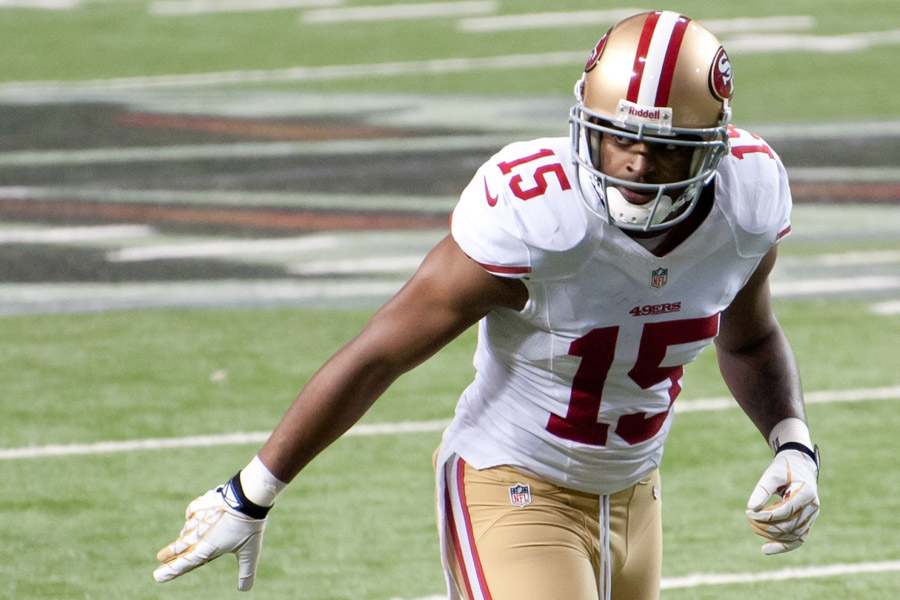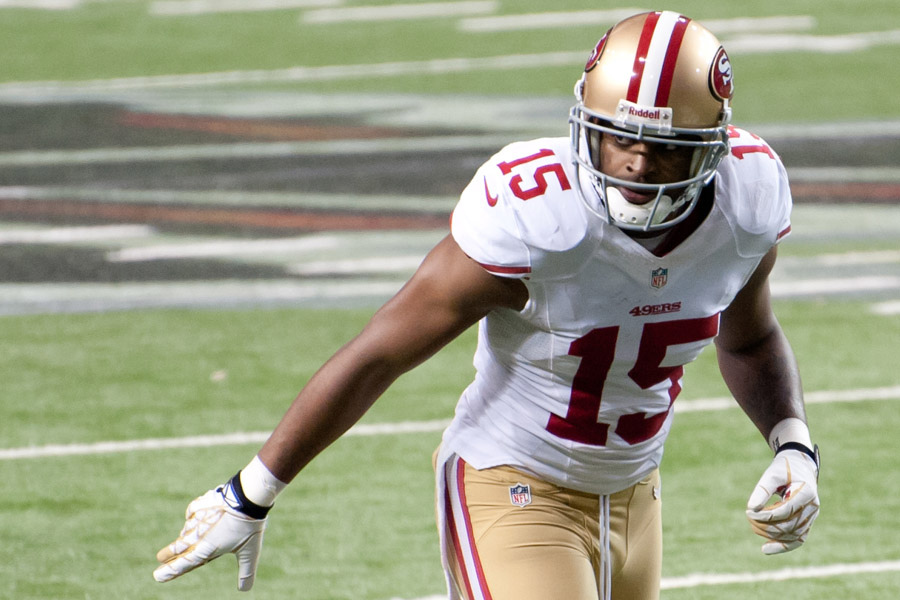
Players Who Grew On Me
Oregon’s Josh Huff leads this list of players who I like more as I leave Mobile than I did upon my arrival. The receiver demonstrated that he could catch the ball with his hands on a consistent basis. While he doesn’t make receptions at the level of difficulty we see from the top receivers in the NFL, he caught a few passes where he had to lay out for the ball and made a few tough plays down field against tight coverage in the end zone. I’ll be reviewing my game research and watching more of Huff in the coming weeks.
I am not among the draft analysts bullish on Antonio Andrews. However, the Western Kentucky running back demonstrated some sweet movement as a route runner and some maturity as an interior runner. I still don’t see Andrews as a future starter, but I’ll be taking another look because he’s a bigger, stronger back than I thought at a surprising 225 pounds and he did some things at practice a little better than I anticipated from him as a decision-maker.
Northwestern’s Kain Colter made an excellent catch up the flat on a go route that handily beat Pierre Desir in practice today. The throw led Colter a little far, requiring a diving extension with his back to the quarterback. This was one of the types of targets I wanted to see from the QB-WR conversion project and Colter came strong. His breaks still need a lot of work, but he’s held his own this week and I’m more optimistic about his potential than I was when I arrived.
Shaq Evans also had an excellent catch in the corner of the end zone in tight coverage on an under-thrown ball this morning. The acrobatic effort cost Evans some practice time because he landed funny on his leg and walked to the sideline with a slight limp and trying to jog off the injury before realizing it wasn’t going away.
Evans has dropped the ball multiple times this week, but they were often situations one could explain away with logic that could exonerate him, including poor communication from the quarterback with regards to the placement and timing of the throw and difficult adjustments required in tight coverage. I believe his hands are better than the final outcome of these targets revealed, but there will be analysts who think otherwise. The UCLA receiver will be a mid-to-late pick, but I think he has potential to grow into a starter one day.
Jerick McKinnon flashed some speed after a cutback that his tape hinted at, but did not truly fulfill. I’m still not sure this run during 11-on-11’s was a fair indication of his speed, but it was more than what I saw against Florida and Georgia. His performance was a positive step towards convincing a more cynical viewer like me that he could emerge as a more than a special teams player.
Players Who Lost a Little In My Eyes
Jordan Matthews’ skill at making the tough catch in the thick of the hit zone between the hashes is something that endears him to me. Truth be told, his difficulty separating from defenders in this practice on a daily basis is an issue. Matthews’ is big and strong enough to bait a corner into a poor angle and then use hands to knock the defender off-balance. He did this well for some big plays this week.
What Matthews couldn’t do was separate deep without initiating contact. There were multiple plays over the past few days where Matthews failed to earn separation within the first five yards and it prompted him to initiate contact a second time with the hope of knocking his opponent off-balance in the process. I didn’t see this as a good sign.
Moreover Matthews is not an efficient runner. I’m not talking about his ball-carrying skills. I’m reiterating something that my colleague Turron Davenport of Pro Football Central – a former college wide receiver – mentioned about Matthews working hard and less efficiently to get to his top speed.
I know that some of my data-head, analytic-thinking brethren have looked at Matthews’ height (and hopefully pay attention to the fact that he’s not as heavy as they assumed) and volume of production in the Vanderbilt offense and believe he’s a bargain compared to Sammy Watkins. I’m leaning harder to the point of view that in this year’s draft Watkins is the “you get what you pay for” option.
Matthews will cost less because he is a lesser physical talent with good, but not great skills. Fantasy owners might not notice the difference at the end of their rookie year, but when it comes to talent the numbers won’t make them right.
Arthur Lynch is a wily route runner. Watching the tight end set up linebackers and safeties in the short zone this week was a lot of fun. I only wish I had Adam Sandler’s remote from the movie “Click” to pause, rewind, and slow-mo the action. As an underneath option, I think Lynch can do good work, but his lack of explosion limits him more as a receiver than I believed when I arrived in Mobile.
Cody Hoffman’s difficulty winning against press coverage – especially today – was an eye-opener. The South team corners have grown more patient when facing Hoffman’s opening release moves and the receiver had difficulty moving them off their spots. The result was frequent collisions with defenders that disrupted Hoffman’s gate, balance, and timing.
There’s a good chance that Hoffman will trick a few defenders on the North squad during the game because they aren’t familiar with him. This is why the practices reveal more than the game. The sessions this week are indicative of how NFL teams will adjust over time and become familiar with a player’s style. The game is more like the first game or two where that familiarity isn’t game.
Unfortunately, you’ll see fans tout a player because of a good in-game performance when there’s often a lot more to it than the guy being a “gamer.” Hoffman might earn that “gamer” label, but the practices revealed a long-strider with a quick first step but not the guile or technical repertoire to win at a consistent rate. He’s capable of amazing catches, but the consistency is missing right now.
Inconclusive Evidence
Davenport told me that Wake Forest’s Michael Campanaro is coming off a collarbone injury. The receiver had good moments as an underneath option this week. However, I still don’t have a good feel for his skill to separate and make difficult plays against physical coverage.
Jimmy Garappolo is the hot item this week. I didn’t see enough to form an opinion. I wish I did, but what I witnessed was a quarterback with Derek Carr’s size, some true zip in the range of 10-20 yards, and a consistent predilection for placing the ball to the back shoulder or hip of receivers when the more optimal choice was leading them down field.
At first glance, there’s a lot of open space that Eastern Illinois’ offense generated for Garappolo. I’m looking forward to examining this quarterback’s game in greater detail.
Wyoming wide receiver Robert Herron’s practice performances were predictable in the sense that he experienced a slew of 2-3 dropped passes during a period of practice and then caught everything else, including some difficult targets. I didn’t see this type of behavior on tape, but I want to re-examine him nonetheless.
They Are Who I Thought They Were
Versatile, agile, and mature between the tackles, Charles Sims is a Senior Bowl darling. You’ve read enough about him on my blog, go here.
Jared Abbrederis may not be the size I thought he was, but he’s the same fine all-around receiver I saw at Wisconsin. He’s a player I’d love to have on an NFL team who can play a variety of roles as a returner and receiver.
Quarterbacks Stephen Morris and Logan Thomas offer eye-popping physical characteristics and flashes of promise, but lack the conceptual feel or the game and consistency to generate interest beyond a late-round pick (save a rogue team that falls in love with looks over the substance of their performances).
C.J. Fiedorowicz is a blocking tight end in training. Gator Hoskins is an H-back in training. And arguably the best potential all-around tight end was Crockett Gillmore from Colorado State – a late edition who, along with the likes of Alex Bayer, were more intriguing options than the original picks for this game. Bayer was not in attendance, but Gillmore made a beautiful over the head catch about 25 yards down field on a corner route and his blocking was physical and on-point today.
Jeff Janis continues to intrigue folks who see the big body with a reasonably quick gait, but ignore that he caught over 75 percent of his targets against his body and didn’t have more than a handful of receptions on targets of moderate difficulty.
I almost gave Ryan Grant consideration in my tier of players who raised their standing in my eyes. He had some slick releases and did a fine job of getting on top of defenders early on vertical routes. There were still several routes where he lost control of his footing trying to break harder than his balance would allow. I liked the effort, but as I mentioned during the preview, Grant has to demonstrate consistency. This was a step in the right direction.
For more Senior Bowl Info also check out:
- The Senior Bowl Preview
- The Senior Bowl Weigh-In
- Day 1 Notes for Offense and Media Night
- Day 1 Notes for Defense
- Does the Senior Bowl Put Edge Rushers at a Disadvantage?
- Day 2 Notes for Defense
- Day 3 Notes for Defense
For analysis of skill players in this year’s draft class, download the 2013 Rookie Scouting Portfolio.The 2014 RSP will available April 1 and if you pre-order before February 10, you get a 10 percent discount. Better yet, if you’re a fantasy owner the 56-page Post-Draft Add-on comes with the 2012 – 2014 RSPs at no additional charge and available for download within a week after the NFL Draft. Best, yet, 10 percent of every sale is donated to Darkness to Light to combat sexual abuse. You can purchase past editions of the Rookie Scouting Portfolio for just $9.95 apiece.







